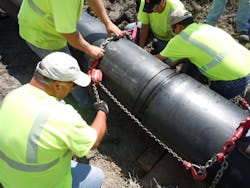South Dakota DOT maintenance crew relines old culverts
Two corrugated metal-pipe (CMP) culverts located under Highway 50 in Chamberlain, S.D., were in danger of failing. One culvert was a 42-in.-diam. CMP and the second culvert was a 30-in.-diam. CMP. The culverts were located three-quarters of a mile apart from one another. The South Dakota Department of Transportation (DOT) regional office wanted to keep the lanes of traffic open during the repair, therefore digging and replacing the pipe was not an option.
SDDOT Mitchell Area District Office Engineer Tammy Williams heard about using a trenchless method of relining the pipes as an alternative to digging and replacing the damaged culverts. The material chosen to reline the 42-in. CMP was 56 ft of 40-in. Snap-Tite pipe and 68 ft of 24-in. Snap-Tite pipe to reline the 30-in. CMP.
The high-density polyethylene (HDPE) pipe culvert lining system has patented male/female machining at each end of the pipe, which allows the ends to be snapped together, piece by piece, and pushed into the full length of an existing pipe.
The installation also served as a demonstration for area SDDOT officials. Williams was interested in seeing the SDDOT own maintenance crew install the pipe lining system; therefore, it was offered to demo the HDPE solid wall pipe liner installation along side the crew—all within a 48-hour period, without closing down any lanes of traffic.
The crew also worked with its local ready-mix contractor to grout the annular space between the liners and old culverts.
Both culverts were lined and the bulk heads built on the first day of the installation (within eight hours). The grouting took place on the second day and both sites were done by noon that day.
“We learned quite a few things during the demonstration project that you helped our maintenance crew complete,” said Williams. “This learning opportunity is going to benefit us in the future with these types of projects.”
